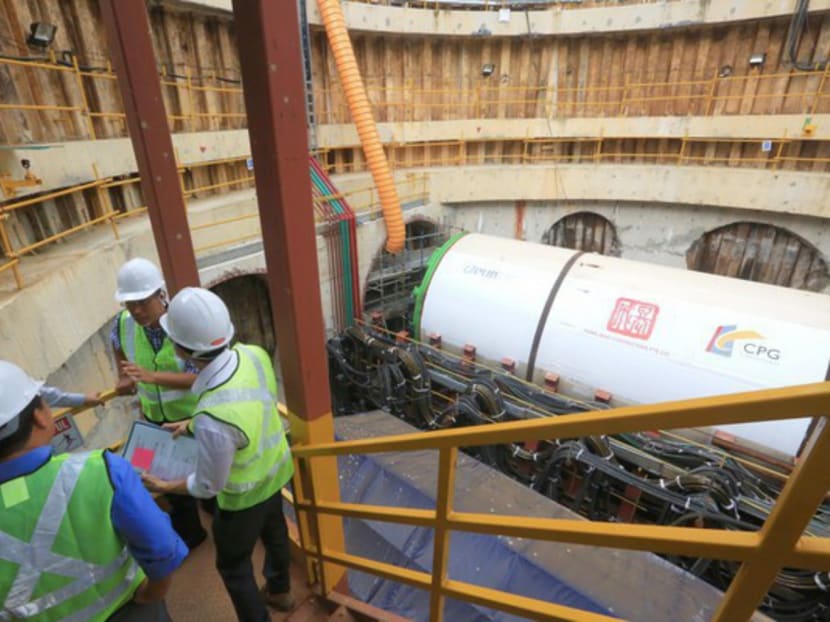Slight delay to Orchard Road flood mitigation works
SINGAPORE — Works to better protect Orchard Road from floods, which include a new Stamford Detention Tank and Stamford Diversion Canal, will be completed only in the first quarters of 2017 and 2018 respectively, a few months later than originally announced.

Minister for the Environment and Water Resources, Mr Masagos Zulkifli, visiting the tunnelling shaft of Stamford Diversion Canal during the Media visit of the Stamford Diversion Canal and Stamford Detention Tank worksites as part of the Drainage Improvement Programme, on June 9, 2016. Photo: Koh Mui Fong/TODAY
SINGAPORE — Works to better protect Orchard Road from floods, which include a new Stamford Detention Tank and Stamford Diversion Canal, will be completed only in the first quarters of 2017 and 2018 respectively, a few months later than originally announced.
The anti-flood measures were introduced after the popular shopping belt was hit by a series a flash floods between 2010 and 2012. Flooding occurs when the Stamford Canal, the main drainage artery in Orchard Road, overflows with rainwater.
The detention tank, which will temporarily hold stormwater from existing drains along Holland Road, was originally slated to be completed by this year. The diversion canal, which will divert stormwater in the upstream section of the Stamford Canal catchment towards the Singapore River and eventually into the Marina Reservoir, was supposed to be completed by next year.

Commenting on the delay during a visit to the construction site yesterday, Environment and Water Resources Minister Masagos Zulkifli said soil conditions were “variable and challenging”, and changes had to be made to the original schedule to ensure the works would not disrupt traffic or pedestrians.
Describing the projects as “complex”, national water agency PUB said hard rock encountered during the tank’s construction required more time and effort to break it down.
Works for the diversion canal are also being carried out in densely built-up areas and require “detailed investigation” to ensure services such as cables and pipes would not be affected by tunnelling. When completed, the detention tank and diversion canal will ease the rainfall load on Stamford Canal by 30 per cent, PUB said in a progress update briefing yesterday.
The S$158 million, 2km diversion canal, stretching from Tanglin Road to Grange Road and off Kim Seng Road, will divert stormwater in the upstream section of the Stamford Canal catchment — about one-third of the entire 630ha catchment area — away from the Stamford Canal.
The stormwater will instead flow down the diversion canal towards the Singapore River, and eventually into the Marina Reservoir.
The first phase of the diversion canal construction in Tanglin and Kim Seng areas, involving the construction of covered box drains, is about 60 per cent complete.
Tunnelling works for a 1km stretch beneath Grange Road for the second phase of construction will begin next month. Construction of the S$69 million detention tank is also underway beneath Singapore Botanical Gardens’ coach park, where excess rainwater in drains along Holland Road will overflow into a chamber with two pipes to channel the water into the tank using gravity.
When sensors detect that water levels in drains have subsided, the tank will automatically release water back into the Holland Road drains and flow into the diversion canal.
Besides improving flood protection for Orchard Road, the two projects also serve to mitigate the effects of more variable weather patterns due to climate change, such as more frequent intense rainfall, said Mr Masagos.
Asked about the flood risk during the monsoon period, he said there is “more risk now than ever”, and Singapore is particularly vulnerable with many built-up and concreted areas.
“So, we have to mitigate that (flood risk) and make sure that in the event that heavy intense rainfall happens … we have enough measures where we can detain the water before it flows into the river or canals, as well as widening our canals and drains so that it can take up the volume,” he added.









